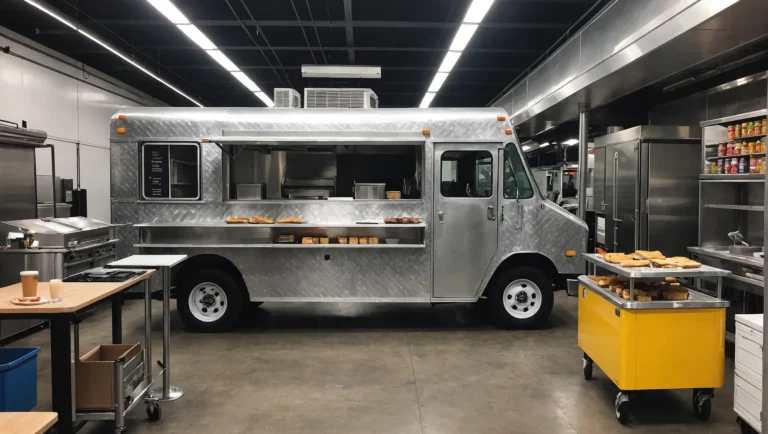Starting a food truck business in 2024?
You’ll need more than just a killer recipe and a catchy name to succeed. Having the right equipment is essential to prep, cook, and serve your signature dishes efficiently and consistently.
But with so many options out there, it can be overwhelming to figure out exactly what you need.
That’s where this comprehensive food truck equipment checklist comes in. We’ve broken down the must-have items for every stage of your mobile kitchen operations, from cutting boards and knives for prep to serving utensils and disposable cutlery for customers. Thinking of initiating your own food truck venture? This guide outlines crucial steps for beginning a food truck business, ensuring you’re equipped for success from day one.
Plus, we’ll cover key factors to consider when selecting and modifying your food truck vehicle, the necessary equipment, navigating permits and regulations, and optimizing your menu for maximum profitability.
So whether you’re a seasoned food truck pro or just starting out, this guide has everything you need to ensure your mobile kitchen is fully equipped for success in 2024 and beyond.
Save 80% of delivery management time
We handle everything:
- Dedicated operations manager
- Real-time tracking dashboard
- Automated customer notifications
- Urgent issue resolution
Essential Food Truck Equipment for Prep, Cooking, and Serving
Starting a food truck business requires careful planning and the right food truck equipment to ensure smooth operations and satisfied customers. In this section, we’ll cover the essential equipment needed for food preparation, cooking, and serving in your food truck.
Food Preparation Equipment
Food prep is the foundation of any successful food truck. You’ll need:
Cutting boards and knives for slicing ingredients
Mixing bowls and utensils for preparing sauces and dishes
Food processors and blenders for efficient prep work
These tools will help you prepare fresh, high-quality ingredients for your dishes.
Cooking Equipment For Food Trucks
Your cooking equipment is the heart of your food truck. Essential items include:
Grills, griddles, gyro machines and stovetops for cooking main dishes
Deep fryers for crispy sides and appetizers to make french fries or burgers
Ovens for baking and reheating pre-made items
According to industry experts, these are the most common cooking equipment used in food trucks.
Serving Equipment
To serve your customers efficiently and maintain a professional image, you’ll need:
Serving utensils like tongs, ladles, and spatulas
Disposable plates, bowls, and cutlery for customers
Napkin dispensers, paper towels and condiment holders for convenience
Drink dispensers, cash registers, or POS systems for efficient service
These items will help you serve your dishes and drinks more quickly and keep your customers happy.
When selecting your food truck equipment list, consider your menu, space limitations, and budget. Investing in high-quality, durable food truck equipment list now will save you money in the long run and ensure your food truck runs smoothly.
Food Truck Equipment List
Essential cooking equipment for efficient food preparation and service
Key storage solutions for ingredients, supplies, and organized workflow
Critical safety features to ensure compliance and protect your business
Refrigerators and Freezers: Keeping Ingredients Fresh
Proper refrigeration is crucial for food safety and quality. In a food truck, space is limited, so choosing the right refrigerators and ice cream freezers is key. Look for units with good insulation, adjustable shelves, and easy-to-clean surfaces. Consider a combination of reach-in and undercounter units to maximize storage while keeping frequently used foods and items accessible.
Reach-in units are the workhorses of a food truck kitchen. They come in various sizes and configurations, from single-door to triple-door models. Some features to look for include:
Adjustable, heavy-duty shelving
Interior lighting for visibility
Digital temperature controls and displays
Self-closing doors
Undercounter units fit beneath worktables and prep surfaces, saving valuable space. They’re great for storing frequently used ingredients or prepped items. Consider models with:
Shallow depth for easy access
Drawers or doors, depending on your needs
Front-venting for built-in installation
Durable construction to withstand frequent use
Worktables and Prep Surfaces: Creating an Efficient Workflow
Well-designed worktables and prep surfaces are essential for a smooth cooking process. In a food truck, every inch counts, so look for solutions that maximize space and functionality. Stainless steel is the material of choice for its durability, ease of cleaning, and resistance to corrosion.
Worktables with undershelves provide extra storage space for pots, pans, and other equipment. They come in various lengths and widths to fit your food truck’s layout. Some features to consider:
Adjustable bullet feet for leveling on uneven surfaces
Backsplash to protect walls and prevent spills
Reinforced legs for stability during transport
Dedicated cutting boards and prep surfaces help prevent cross-contamination and keep your workflow organized. Look for:
Color-coded boards for different food types
Non-slip feet or mats to keep boards in place
Durable, knife-friendly surfaces like high-density polyethylene (HDPE).
Sinks: Handwashing and Dish Cleaning Essentials
Proper handwashing and dish cleaning are critical for food safety and sanitation. In a food truck, you’ll need at least one handwashing sink and a three-compartment sink for washing, rinsing, and sanitizing dishes and equipment.
Handwashing sinks should be easily accessible and separate from food prep areas. Look for:
Hands-free operation with knee or foot pedals
Built-in soap and paper towel dispensers
Hot and cold water supply with mixing valve
A three-compartment sink is required for proper dish cleaning and sanitizing. Choose a size that fits your food truck’s needs and layout. Features to consider:
Deep, spacious bowls for large pots and pans
Drainboards on one or both sides for air-drying
Faucet with sprayer attachment for rinsing.
Ventilation Hoods and Fans: Maintaining Air Quality
Proper ventilation is essential for removing smoke, steam, and grease from your food truck kitchen. It helps maintain air quality, prevent odors, and keep your equipment clean. A commercial-grade ventilation hood with exhaust fans is a must-have.
Type I hoods are required for food trucks with grease-producing equipment like fryers and griddles. They feature built-in grease filters and a fire suppression system. Consider:
Sizing the hood to cover all cooking equipment
Adequate exhaust fan power for your truck’s volume
Makeup air system to replace exhausted air
Exhaust fans and ducts work with the hood to remove air from the kitchen. They should be sized and installed correctly to ensure proper airflow. Look for:
UL-listed fans rated for commercial use
Easy-to-clean, grease-resistant duct material
Proper duct insulation to prevent condensation
Fire Suppression Systems: Ensuring Safety Compliance
A fire suppression system is a critical safety feature for any food truck with cooking equipment. It’s designed to automatically detect and extinguish fires, protecting your food truck supplies, and its occupants. Most local regulations require a UL-300 compliant system.
UL-300 systems use wet chemicals to suppress fires in hood, duct, and cooking appliances. They typically include:
Heat-sensing detectors in hood and duct
Nozzles over each appliance and in duct
Manual pull station for activation
Automatic fuel shutoff for gas appliances
Regular maintenance and inspection are crucial to keep safe temperatures and ensure your fire suppression system works when needed. Schedule:
Semi-annual servicing by a licensed technician
Monthly visual inspections of nozzles, hoses, and tanks
Annual fire inspection by local authorities
By investing in the right food truck equipment and safety features, you’ll create a solid foundation for your food truck business. With efficient workflow, proper sanitation, and compliance with regulations, you’ll be well-equipped to serve delicious meals to your customers while protecting your team and your business.
Factors to Consider When Starting a Food Truck Business
Choosing the right vehicle, obtaining permits, and complying with regulations are crucial for success
Menu planning and inventory management can make or break your food truck’s profitability
Investing in high-quality equipment and establishing a strong brand identity sets you apart from competitors
Vehicle Selection and Modification
Selecting the right vehicle is one of the most important decisions when starting a food truck business. The size of your truck should accommodate your menu and equipment needs while allowing for limited space for efficient workflow. A 16-foot truck is suitable for most menus, but a 18-20 foot truck may be necessary for more extensive menus or larger equipment. Dive into the various food truck models to determine which configuration aligns perfectly with your mobile culinary venture’s requirements.
Proper insulation, ventilation, and plumbing are essential for maintaining food safety and creating a comfortable working environment. Consult with experienced food truck builders to ensure your vehicle meets all health department requirements. A well-designed kitchen layout optimizes the available space and promotes smooth operations, reducing wait times and increasing customer satisfaction.
Permits, Licenses, and Regulations
Navigating the various permits, licenses, and regulations required for food trucks can be overwhelming. Research your local health department’s requirements early in the planning process to avoid delays or legal issues. Common permits and licenses include:
Business license
Food handler’s permit
Health department permit
Fire department inspection
Parking permits
Failing to comply with regulations can result in fines, temporary store closures, or even the loss of your business. Develop a checklist of required permits and licenses, and create a schedule to ensure timely renewals.
Menu Planning and Inventory Management
Crafting a focused, appealing menu is key to attracting and retaining customers. Limit your menu to 6-12 core items, allowing for seasonal or weekly specials. A streamlined menu reduces inventory costs, minimizes waste, and improves food quality. Explore innovative food truck menu design tips that not only enhance your menu’s appeal but also guarantee to capture the interest of your target audience, driving up your customer base.
Sourcing high-quality, cost-effective ingredients is essential for maintaining profitability. Establish relationships with local suppliers, farmers markets, and wholesale distributors to secure supplies at the best prices and quality. Regularly review your ingredient costs and adjust menu prices as needed to maintain desired profit margins.
Implementing an inventory tracking system helps minimize waste and optimize ingredient purchasing. Use digital tools like POS systems with inventory management features or standalone inventory apps to monitor stock levels and track usage.
Branding and Marketing Strategy
Developing a strong brand identity and implementing an effective marketing strategy sets your food truck apart in a competitive market. Create a memorable logo, choose a color scheme, and design attractive signage to make your truck visually appealing and easily recognizable.
Leverage social media platforms like Instagram, Facebook, and Twitter to engage with customers, announce locations, and promote specials. Encourage customers to tag your food truck in their posts and share their experiences to generate word-of-mouth marketing.
Participate in local food truck events, festivals, and catering opportunities to expand your customer base and increase revenue streams. Collaborate with other food trucks, local businesses, or charities to cross-promote and build community relationships.
Staffing and Training
Building a reliable, skilled team is essential for providing excellent customer service and maintaining food quality. Hire staff with food service experience, positive attitudes, and strong work ethics. Develop a comprehensive training program that covers food safety, customer service, and operational procedures.
Clearly communicate roles, responsibilities, and performance expectations to ensure a cohesive team. Foster a positive work environment by recognizing employee achievements, offering competitive wages, and providing opportunities for growth.
Food Truck Prep Equipment Checklist
Invest in high-quality prep tools to save time and ensure consistent results
Use appliances like rice cookers and sous vide machines for hands-off cooking
Proper storage solutions help maintain ingredient freshness and maximize space
Essential Prep Tools
When outfitting your food truck kitchen, it’s crucial to have the right prep tools on hand. Mandoline slicers are a must-have for achieving consistent vegetable cuts quickly. Chef Alton Brown swears by his Japanese mandoline, stating, “It’s the one tool I can’t live without in my kitchen.”
Immersion blenders are another versatile tool, perfect for whipping up soups and sauces right in the pot. “An electric immersion blender is a game-changer for food trucks,” says food truck owner Jenna Smith. “It saves space and makes it easy to create smooth, creamy soups and sauces on the go.”
Don’t forget the importance of accurate portion control. Invest in high-quality digital scales to ensure every dish is consistent and profitable. “Using a digital scale has helped us reduce food waste and maintain consistent portion sizes, which is key for our bottom line,” notes food truck chef Mark Johnson.
Time-Saving Appliances
In the fast-paced world of food trucks, time is money. Incorporating time-saving appliances into your prep routine can help streamline operations and improve efficiency.
Rice cookers and slow cookers allow you to prepare grains, beans, and braised meats hands-off, freeing up valuable time for other tasks. “Our rice cooker is a lifesaver during busy service hours,” says food truck owner Lisa Chen. “We can set it and forget it, knowing we’ll have perfectly cooked rice every time.”
Sous vide machines are another valuable tool for food trucks, offering precise temperature control for consistent results. Chef and food truck consultant Mark Matsumoto recommends using sous vide for proteins, stating, “Sous vide cooking ensures even cooking and helps retain moisture, which is especially important when working with large quantities in a small kitchen with limited space is.”
Food Safety and Storage
Proper food storage is critical for maintaining food safety in a food truck setting. According to food safety expert Dr. Elizabeth Andress, “Proper storage and handling of food and beverages are crucial to preventing foodborne illnesses. Food trucks must ensure that all ingredients are stored at the correct temperatures and handled hygienically to minimize the risk of contamination.”
By incorporating these essential tools and appliances into your food truck kitchen, you can streamline operations, improve efficiency, and ensure consistent, high-quality dishes.
Optimizing Your Food Truck Menu
Streamline your menu to balance variety and efficiency
Accommodate dietary restrictions to attract a broader customer base
Regularly analyze sales data to make informed menu decisions
Balancing Variety and Efficiency
Offering a diverse menu is essential for attracting customers, but it’s equally important to maintain efficiency in your food truck kitchen. Strike a balance by featuring a mix of classic favorites and unique specialties that showcase your culinary expertise. As Jodi Liano, founder of San Francisco Cooking School, advises, “Keep your menu focused and do a few things really well. It’s better to have a small menu with exceptional dishes than a large menu with mediocre ones”.
To streamline your menu, limit the number of items to a manageable size. This allows your team to master each dish, ensuring consistent quality and faster service. Aim for a menu with 8-12 core items, and consider offering daily specials to keep things fresh. When making changes to your menu, analyze item popularity and profitability. “Pay attention to your sales data and customer feedback,” recommends food truck consultant Andrew Rigie. “If an item isn’t selling well or is causing operational challenges, don’t be afraid to remove it from the menu”.
Accommodating Dietary Restrictions
In today’s diverse dining landscape, accommodating dietary restrictions is crucial for expanding your customer base. Offer vegetarian, vegan, and gluten-free options to cater to a wider range of diners. “Having at least one vegan and one gluten-free option on your menu can make a big difference,” notes Tina Clark, owner of Phoenix-based Naturally Sweet Food Truck. “It shows that you’re inclusive and care about your customers’ needs”.
Clearly label menu items with allergen information to help customers make informed choices. Train your staff on proper food handling techniques and cross-contamination prevention to ensure the safety of your diners with allergies or sensitivities. As food allergy expert Dr. Scott Sicherer advises, “Establishing a food allergy protocol and training your staff accordingly is essential for creating a safe and welcoming environment for all customers”.
Gearing Up for Success With The Right Food Truck Supplies
With the right food truck equipment and a well-planned menu, your food truck can thrive in the competitive culinary world. From efficient prep tools to reliable cooking appliances, each piece plays a crucial role in your success.
As you embark on this exciting journey, remember that investing in the highest quality of equipment, obtaining necessary permits, and crafting a menu that balances variety and efficiency are key to building a loyal customer base.
What’s one step you can take today to bring your food truck vision to life? Whether it’s researching local regulations, sketching out your dream kitchen layout, or testing a new recipe, every action brings you closer to your goal.
So, roll up your sleeves, fire up some gourmet burgers on the grill, and get ready to serve up delicious meals served on wheels. Your food truck adventure awaits!














